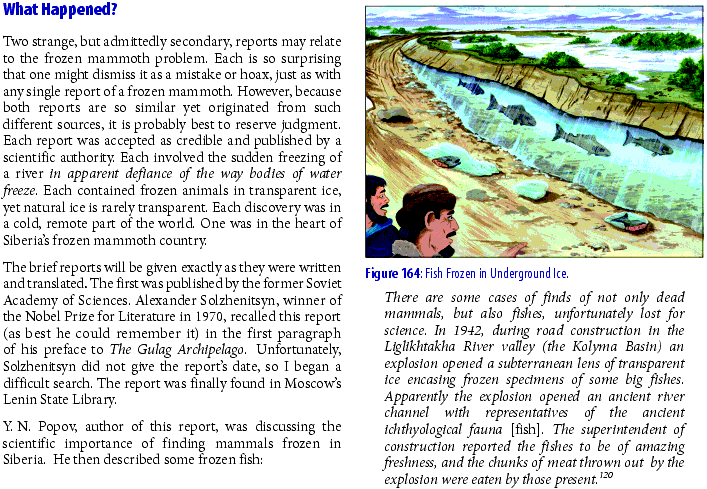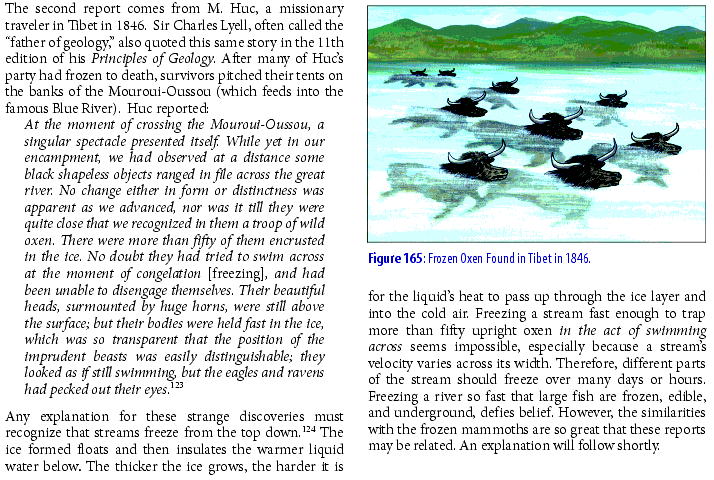Theories Attempting to Explain Frozen Mammoths
Ten theories have been proposed to explain the frozen mammoth puzzle. Each will be described below as an advocate would.
Fruitful theories answer not only the obvious, initial questions but also solve perplexing and seemingly unrelated problems. As we unravel the mystery of the frozen mammoths, we may answer broader questions and even uncover a sequence of dramatic, global events.
Robust theories also provide details that result in surprising and testable predictions. Keep this in mind as we examine all ten explanations. With each, ask yourself, “What predictions can this theory make?” If predictions are missing, the theory is probably weak.118 If theories could not be published unless they included many details and specific predictions, we would be mercifully spared many distractions and false ideas.
Hydroplate Theory. [For a more detailed description of the hydroplate theory, read pages 111–147.] On that terrible day, the rupture of the Earth’s crust passed between what is now Siberia and Alaska in minutes. Jetting water from the fountains of the great deep first fell as rain. During the next few hours, some of the accelerating and expanding subterranean water that went above the atmosphere (where the effective temperature is several hundred degrees below zero Fahrenheit) froze and fell as hail.119 Some animals were suddenly buried, suffocated, frozen, and compressed by tons of cold, muddy ice crystals from the gigantic “hail storm.” Dirt in this ice prevented it from floating as the flood waters submerged these regions after days and weeks. Blankets of this muddy ice, hundreds of feet thick, insulated and preserved many animals during the flood phase. As the topmost layers of ice melted, the dirt in that ice remained and settled—blanketing and further insulating the deeper ice and buried animals.
Months later, after mountains were suddenly pushed up, the Earth’s balance shifted, the Earth slowly “rolled” 34°–57°, so Siberia and Alaska moved from temperate latitudes (similar to north-central United States today) to their present positions. [For details, see Endnote 84 on page 145.] As the flood waters drained off the continents, whatever icy graves existed in warmer climates melted, and buried animals decayed. However, many animals, buried in what are now permafrost regions, were preserved.
These conclusions can be reached quite simply. The evidence showing compression and suffocation of the frozen mammoths implies rapid burial. Rapid burial and sudden freezing suggest a supercold “ice dump.”
compression + suffocation = rapid burial
rapid burial + sudden freezing = an “ice dump”
Lake Drowning Theory. 121 No catastrophe occurred. The well-preserved mammoths, with food in their stomachs and between their teeth, died suddenly, probably from asphyxiation resulting from drowning in a partially frozen lake, river, or bog. Such burials can preserve animal—and even human—tissue for thousands of years.
Crevasse Theory. Some mammoths fell into ice crevasses or deep snowdrifts. This protected them from predators, while ice preserved them for thousands of years.122
Mud Burial Theory. In Siberian summers, the top foot or so of tundra thaws, so larger animals, even men, can easily become stuck—standing upright. Herds of mammoths, rhinoceroses, and buffalo made summer migrations to northern Siberia and Alaska. Some became stuck in this mud; others were overwhelmed and suffocated in mudslides. Still others died for various reasons and were then buried in slow mudflows during several summer thaws. Sudden cold spells—sometimes followed by long, cold winters—froze and preserved many mammoths.125
River Transport Theory. Mammoths and other animals lived farther south in the temperate zone of Asia where food was abundant. Flooding rivers floated their remains from Central Siberia on the north flowing rivers.126
Extinction-by-Man Theory. Man exterminated mammoths, just as man almost exterminated the buffalo. Man, in hunting mammoths, pursued and pushed them north into Siberia and Alaska. There, they died from harsh weather, lack of food, or the direct killing by man.127
Bering Barrier Theory. As ice accumulated on continents during the last Ice Age, sea level was lowered by 300 feet and the Bering Strait was closed. This newly created land bridge allowed people and animals, including mammoths, to migrate between Siberia and Alaska and onto Arctic islands. Because the warmer Pacific waters could no longer mix through the Bering Strait with the cold Arctic Ocean, the Pacific waters became even warmer and the Arctic waters even colder. The resulting heavy evaporation from the Pacific caused extreme snow falls on higher, colder land masses north of the Bering barrier. Mammoths and others were buried in severe snow storms early one fall. As the Ice Age ended, heavy rains washed soil down on top of compacted snow deposits, forming rock ice. Some frozen mammoths and rock ice are still preserved. Since then, glacial melting raised sea levels and reestablished the Bering Strait.128
Mild Ice Age Theory.129 During snow and dust storms about 700 years after the global flood, some mammoths were frozen, buried, suffocated, and preserved—a few standing up. Here is how it happened.
The flood waters were warm, if not hot, because they came from 3,000–10,000 feet below the Earth’s crust where temperatures are 30–100°F hotter. Warm, postflood oceans produced both heavy evaporation and snow fall. As snow depths increased, the Ice Age began;130 it lasted about 700 years—until the oceans cooled sufficiently. Thick ice sheets built up in continental interiors and lowered sea levels somewhat. During those 700 years, mammoths migrated from the mountains of Ararat to northern Siberia and from there to Alaska during a brief exposure of a land bridge across the Bering Strait. With warm winds off the warm Arctic Ocean producing a tolerable climate for the ice age mammoths, their numbers grew to about 10 million. Other temperate animals were also able to live at those high latitudes. As the oceans cooled, fierce storms developed. Blowing dust, called loess, suffocated and buried most mammoths, some standing up. Other storms converted the dust to permafrost.
Shifting Crust Theory. Before the last Ice Age, the Hudson Bay was at the North Pole. Siberia and Alaska were farther south and supported abundant vegetation and large herds of mammoths. As vast amounts of ice accumulated at what was then the North Pole, the crust on the spinning Earth became unbalanced and slid, moving Siberia northward. Because the Earth is slightly flattened at the poles and bulges at the equator, the shifting crust produced many ruptures. Volcanic gas was thrown above the atmosphere where it cooled and descended as a supercold “blob.” Airborne volcanic dust lowered temperatures on Earth and caused phenomenal snow storms. Mammoths and other animals living in Siberia and Alaska were suddenly frozen and buried in extremely cold snow. Some are still preserved.131
| Key: |
 |
Explained by theory. |
|
|
 |
Theory has moderate problems with this item. |
|
|
 |
Theory has serious problems with this item. |
|
|
N/A |
Not Applicable |
| The numbers in this table refer to amplifying explanations on pages 281–291. |
||
Meteorite Theory. At the end of the last Ice Age, a large iron meteorite hit Earth’s atmosphere. The resulting heat temporarily melted the top layers of the frozen tundra, causing mammoths to sink into muck. Poor visibility caused others “to blunder to their deaths in icy bogs.”132

